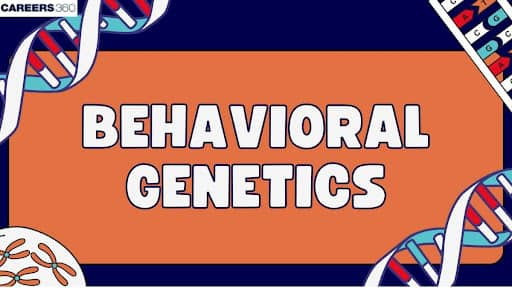Behavioural Genetics: Definition, History, Methods Types & Examples
Behaviour genetics, also known as psychogenetics, is the study of how genes affect human behaviour. It also looks at how both environment and heredity interact to influence human behaviour. Researchers try to understand how much of our behavior is passed down through genes. Based on the core principles of inheritance and variation, they also study the patterns within families and twins to find links between genetics and behaviour.
This Story also Contains
- Definition of Behavioural Genetics
- Three laws of Behavior genetics
- Methods of Study of Behavioural Genetics
- Criticism of Behavioral Genetics
- MCQs on Behavioral Genetics

In addition to genetics, behavioral genetics also focuses on how the environment interacts with genes. This debate, “nature vs nurture,” argues whether actions of a person are influenced by genetic inheritance or by life experiences. Most scientists agree that both play important roles. By understanding these interactions, behavioral genetics helps better understand human development, behavior, and psychological differences.
Definition of Behavioural Genetics
Behavioural genetics is the study of how genes of an organism affect its behaviour. It investigates whether a person's genes have an impact on their habits, manners, gestures, posture, etc. Behaviour is often influenced by a combination of genetic factors and environmental conditions such as family upbringing and life experiences.
Behaviour genetics is a branch of science that examines how genetics affects behavior and questions the nature vs. nurture controversy.
It also explains the role of genes, which are basic units of heredity, consisting of DNA or RNA that is passed down from one generation to the next.
They transport genetic data, particularly proteins, through amino acid sequences.
On the other hand, a person’s physical and mental characteristics are not only influenced by genes but also by a variety of factors like environment, upbringing, and life experiences.
Three laws of Behavior genetics
Three basic laws of Behavior genetics are discussed below:
First Law: All behavioural characteristics in people are inherited.
Second law: The impact of growing up in the same family has less significance on behaviour than the impact of genes.
Third Law: There is a significant amount of variation in complex human behavioural traits that cannot be explained by the effects of genes or families.
Methods of Study of Behavioural Genetics
Both humans and animals have been used in the research, but the results from the animal studies are more reliable. This is possible because both the environment and genes can be manipulated in a lab setting. These controlled conditions also help in studying gene interaction. The following experiments were performed to study the genetic and environmental influences on behaviour in humans and animals:
Method | Description |
Selective Breeding | It involves using organisms with extreme traits over several generations to study how genetics influences specific behaviors. |
Twin Approach | This study includes identical and fraternal twins to compare their differences in behaviour. |
Adoption | This method examines the children who are raised by non-biological parents to understand the impact of genetics and environment on behavior. |
Three major conclusions of these studies include:
Genes play a role in both human genetic disorders and characteristics.
Members of the same family often become different from each other over time due to environmental factors rather than becoming more similar.
As people get older, the influence of genes usually becomes more significant.
Criticism of Behavioral Genetics
Behavioral genetics has faced criticism for giving too much importance to heredity and neglecting the role of environmental factors. Critics argue that human behaviour is complex and cannot be completely explained by genes. Life experiences, personal choices, family upbringing, etc., play an important role in influencing behavior, which cannot be skipped by genetic studies. Moreover, behaviours are also influenced by polygenic inheritance, which makes it difficult to select specific genetic causes.
Some question the accuracy of twin and adoption studies because no two environments are truly identical. Although behavioral genetics helps understand behavior, many believe that it should be used alongside environmental studies. Another concern is pleiotropy, where one gene affects multiple traits, which further complicates the interpretation of genetic influence on specific behaviors.
MCQs on Behavioral Genetics
Q1. Which of the following is the basic unit of heredity in living organisms?
Genotype
Phenotype
Chromosomes
Gene
Correct Answer: 4) Gene
Explanation:
A gene is the basic unit of heredity in all living organisms. It is a segment of DNA that carries the instructions for making proteins, which determine the traits passed from parents to offspring. Genes are located on chromosomes and are responsible for inherited characteristics.
Hence, the correct answer is option 4) Gene
Q2. Variation at the genetic level arises due to a mutation termed
Polyploidy
Polymorphism
Basis of genetic mapping
More than one correct answer
Correct Answer: 2) Polymorphism
Explanation:
Polymorphism refers to the presence of two or more different forms (alleles) of a gene in a population, resulting from mutations. These variations are stable and common enough (usually found in at least 1% of the population) to be considered normal genetic differences. Polymorphisms are an important source of genetic diversity and are used as markers in genetic mapping and studies of inherited traits.
Hence, the correct option is 2) Polymorphism.
Also Read:
Frequently Asked Questions (FAQs)
Behavioral genetics is the study of how a person’s genes and environment influence their behavior.
The examples of behavioral genetics include studies on twin behaviour, intelligence, traits passed on from parents, etc.
The examples of genetic behavior include anxiety, aggression, some learning abilities, and any other traits that run in the family.
Gregor Mendel is known as the father of genetics.